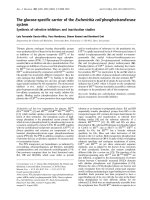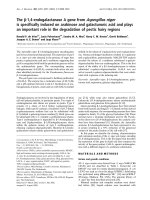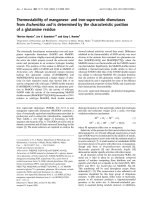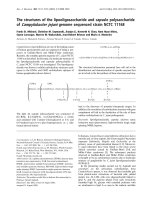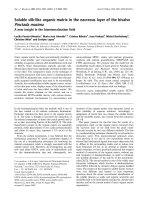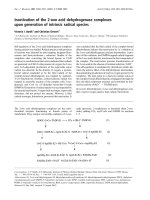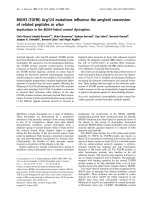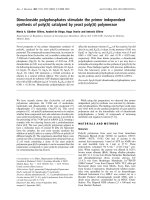Tài liệu Báo cáo Y học: The Fc receptor c-chain is necessary and sufficient to initiate signalling through glycoprotein VI in transfected cells by the snake C-type lectin, convulxin ppt
Bạn đang xem bản rút gọn của tài liệu. Xem và tải ngay bản đầy đủ của tài liệu tại đây (303.73 KB, 10 trang )
The Fc receptor c-chain is necessary and sufficient to initiate
signalling through glycoprotein VI in transfected cells by the snake
C-type lectin, convulxin
Oscar Berlanga
1,2
, David Tulasne
1
, Teresa Bori
3
, Daniel C. Snell
1
, Yoshiki Miura
4
, Stephanie Jung
4
,
Masaaki Moroi
4
, Jonathan Frampton
2
and Steve P. Watson
1
1
Department of Pharmacology, University of Oxford, UK;
2
Weatherall Institute of Molecular Medicine, John Radcliffe Hospital,
Oxford, UK;
3
Division of Medical Sciences, The Medical School, University of Birmingham, UK;
4
Department of Protein
Biochemistry, Institute of Life Sciences, Kurume University, Japan
There is extensive evidence that FcR c-chain couples to the
collagen receptor glycoprotein VI (GPVI) and becomes
phosphorylated on tyrosines upon receptor cross-linking.
However, it is not established whether this receptor complex
is sufficient to initiate the signalling cascade. We transfected
GPVI and the FcR c-chain into the human erythroleukae-
mia cell line K562, which lacks detectable expression of
GPVI and the FcR c-chain. The results show that GPVI is
unable to signal when expressed alone, despite its surface
expression, upon stimulation with the snake C-type lectin,
convulxin. Coexpression of the FcR c-chain confers
signalling properties on the receptor. Furthermore,
cotransfection of the FcR c-chain and two mutant versions
of GPVI shows that the transmembrane arginine and cyto-
plasmic tail of GPVI are necessary for association with the
FcR c-chain. These results demonstrate that reconstitution
of the GPVI–FcR c-chain complex in cells expressing the
necessary signalling network is sufficient to initiate signalling
events in response to convulxin and collagen-related peptide.
Keywords: collagen; collagen-related peptide (CRP);
convulxin; FcR c-chain; glycoprotein VI (GPVI).
Glycoprotein VI (GPVI) is the major signalling collagen
receptor present in platelets and megakaryocytes. It
belongs to the superfamily of immunoblobulin receptors
and is closely related to Fca receptor (FcaR) and natural
killer receptor [1]. The cloned cDNA of GPVI indicates
an ORF encoding a 20 amino-acid signal sequence and a
mature protein of 319 amino acids. Its extracellular
region has two immunoglobulin-like domains and a
mucin-like Ser/Thr region, followed by a transmembrane
and short cytoplasmic tail. GPVI forms a complex with
the Fc receptor c-chain (FcR c-chain), which is respon-
sible for signalling through GPVI [2–4]. Previous reports
on two receptors sharing homology with GPVI, namely
FcaR and paired immunoglobulin-like receptor A (PIR-
A), revealed that they are expressed on the surface of the
membrane independently of the FcR c-chain in cell lines
[5,6], but coexpression with FcR c-chain increases the
level of expression of the receptor at the surface [5,7].
The interaction between FcaRorPIR-AandtheFcR
c-chain occurs in the transmembrane region as the result
of oppositely charged amino-acid residues [6,8]. The
immune receptor tyrosine-based activation motif domain
within the cytoplasmic tail of the FcR c-chain is
responsible for signalling after engagement of the recep-
tor complex [9].
The interaction between platelets and collagen involves
adhesion and activation leading to increased strength of
adhesion, secretion and ultimately aggregation [10–12]. It is
accepted that the integrin a2b1 is the major receptor
supporting strong platelet adhesion to collagen, whereas
GPVI mediates activation [3,13]. The multimeric nature of
collagen means that the development of specific ligands to
either receptor is essential for understanding their relative
contribution to the overall mechanism of platelet–collagen
interaction. Among these, collagen-related peptide (CRP) is
thought to signal specifically through GPVI, as demonstra-
ted by the lack of response to the peptide in GPVI-deficient
platelets [13]. Convulxin, a C-type lectin from the venom of
the tropical rattlesnake Crotalus durissus terrificus,also
specifically recognizes GPVI.
The present results show surface expression of GPVI
independently of the FcR c-chain in COS-7 and K562 cells,
and that the transmembrane arginine and cytoplasmic
domain of GPVI are necessary for association with the FcR
c-chain. Moreover, the FcR c-chain is necessary and
sufficient to initiate the signalling events after GPVI
engagement, as demonstrated for the first time in a
reconstituted system in which both GPVI and FcR c-chain
have been stably expressed.
Correspondence to O. Berlanga, Weatherall Institute of Molecular
Medicine, University of Oxford, John Radcliffe Hospital,
Headington, Oxford OX3 9DS, UK.
Fax:+ 44 1865 222737, Tel.: + 44 1865 222437,
E-mail:
Abbreviations: GPVI, glycoprotein VI; FcRc, Fc receptor c-chain;
CRP, collagen-related peptide; FITC, fluorescein isothiocyanate;
GFP, green fluorescent protein; GST, glutathione S-transferase;
PIR-A, paired immunoglobulin-like receptor A; PMA,
phorbol myristate acetate.
(Received 14 November 2001, revised 20 March 2002,
accepted 30 April 2002)
Eur. J. Biochem. 269, 2951–2960 (2002) Ó FEBS 2002 doi:10.1046/j.1432-1033.2002.02969.x
MATERIALS AND METHODS
Materials
CRP (GCP*[GPP*]10GCP*G, P* ¼ hydroxyproline; the
peptide is cross-linked through the C-terminal cysteines)
was a gift from Drs Barnes, Knight, and Farndale
(Department of Biochemistry, University of Cambridge,
UK). Convulxin was supplied by Drs Leduc and Bon
(Institute Pasteur, Paris, France). Anti-Syk N-19 was from
Santa Cruz (Insight Biotechnology Ltd, Wembley
Middlesex, UK). Fluorescein isothiocyanate (FITC)-
conjugated anti-(human CD36) was from Serotec
(Kidlington, Oxfordshire, UK). FITC-conjugated anti-
rabbit IgG (Fab¢)
2
fragments were from Sigma (Poole,
Dorset, UK). All other reagents were from previously
described sources [3,4,14].
Cell culture and platelet preparation
K562 and Jurkat cells were grown in RPMI-1640
medium, and COS-7 cells were grown in Dulbecco’s
modified Eagle’s medium. Both cell lines were supple-
mented with 1 m
M
glutamine, 100 UÆmL
)1
penicillin,
100 lgÆmL
)1
streptomycin and 10% heat-inactivated fetal
bovine serum under 5% CO
2
/95% air in a humidified
incubator. Cells were kept at exponential phase of growth.
Differentiation of K562 cells was induced with phorbol
myristate acetate (PMA) as previously described [14].
Platelets were obtained from drug-free volunteers on the
day of the experiment. They were isolated as previously
described [3].
Transient and stable transfections
Two different methods of transfection were used: electro-
poration and the calcium phosphate method. For electro-
poration, 5 · 10
6
cells were washed twice in cytomix buffer
(120 m
M
KCl, 0.5 m
M
CaCl
2
,10m
M
K
2
HPO
4
,10m
M
KH
2
PO
4
,25m
M
Hepes, 2 m
M
EGTA, 5 m
M
MgCl
2
,
pH 7.6 adjusted with KOH) supplemented on the day of
experiment with 5 m
M
glutathione and 2 m
M
ATP, and
resuspended in 400 lL cytomix buffer, which was added in
an electroporation cuvette already containing 5–10 lg
plasmid DNA. After electroporation, cells were diluted
to a final volume of 5 mL with complete prewarmed
medium and placed in the incubator. The calcium phos-
phate method was used with COS-7 cells. A mixture
containing 500 lL sterile distilled water, 186 lL1
M
CaCl
2
and 20 lg plasmid DNA was prepared. After 5 min,
750 lL2· HBS buffer [250 m
M
NaCl, 10 m
M
KCl,
1.5 m
M
Na
2
HPO
4
(anhydrous), 50 m
M
Hepes, 12 m
M
dextrose, pH 7.05] was added, and 200 lL of the final
mixture per ml of culture medium was added to the cells.
For transient expression experiments, cells were used after
2 days of transfection. For stable expression, plasmid
DNA was linearized before transfection with a proper
restriction enzyme, and the enzyme inactivated by heat.
After 24 h, cells were separated into at least 24 wells and
exposed to antibiotic (500 lgÆmL
)1
G418 or 500 lgÆmL
)1
hygromycin, as indicated). After 1 week, individual
clones of cells were selected and placed in 96-well plates
for expansion.
Plasmid constructs
cDNAs coding for wild-type human GPVI (F1) or GPVI
mutated in the transmembrane arginine residue to alanine
(R272A) (FA) or with the cytoplasmic tail deleted
(A288STOP) (C1) were cloned into HindIII–XbaIsitesof
pRc plasmid (Invitrogen). pMG plasmid (InvivoGen) is a
bicistronic plasmid for simultaneous expression of two
different proteins. The cDNA coding for human FcR
c-chain was subcloned into SmaI–XbaI sites of multicloning
site 1. pEGFP plasmid, coding for the green fluorescent
protein (GFP), was from Clontech (Basingstoke,
Hampshire, UK). A chimeric protein GPVI–GFP was
made by inserting the cDNA of GPVI into the EcoRI site of
EGFP plasmid.
Immunoprecipitation and affinity precipitation
Cells [(2–4) · 10
6
] were lysed in buffer [10 m
M
Tris 150 m
M
NaCl, 5 m
M
EDTA, 1% (v/v) Triton X-100, 0.5 m
M
phenylmethanesulfonyl fluoride, 1 m
M
Na
3
VO
4
,5lgÆmL
)1
leupeptin, 5 lgÆmL
)1
aprotinin, 0.5 lgÆmL
)1
pepstatin A,
pH 7.3] and rotated at 4 °C for 30 min; they were then
centrifuged for 10 min and the supernatant used to measure
protein concentration. Samples were precleared for 1 h with
30 lL protein A–Sepharose (50%, v/v), centrifuged, and
supernatant used for immunoprecipitation as previously
described [14]. For GPVI affinity precipitation, 5 · 10
8
platelet-protein extract or 500 lg protein extract from the
cell lines was incubated with 15 n
M
convulxin for 2 h.
Convulxin antibody (0.4 lgÆmL
)1
) was added, and incuba-
tions were carried out overnight. Then 30 lLproteinA–
Sepharose was added and the mixture incubated for 1 h.
Samples were washed 4–6 times with lysis buffer and
resuspended in Laemmli sample buffer. A glutathione
S-transferase (GST) fusion protein containing the tandem
SH2 domains of Syk (GST-Syk-SH2) was expressed as
described previously [15], and bound to glutathione–
agarose. Precipitated proteins were separated by SDS/
PAGE and transferred on to poly(vinylidene difluoride)
membranes.
Immunoblotting and ligand blotting
Protein extracts from whole cell lysates or immunoprecip-
itated proteins were used for blotting as previously described
[14]. GPVI and FcR c-chain blotting was performed under
nonreducing conditions. For GPVI detection, membranes
were blocked for 1 h using Tris/NaCl-T containing 5%
skimmed milk, and then incubated with 10 n
M
convulxin
dissolved in Tris/NaCl/Tween [20 m
M
Tris, 137 m
M
NaCl,
0.1% (v/v) Tween 20, pH 7.6] for 1 h at room temperature;
they were then washed and incubated with convulxin
antibody and secondary antibody, both dissolved in Tris/
NaCl-T.
Flow cytometry
Cells were resuspended in Tyrodes/Hepes or NaCl/P
i
buffer
containing 1% human serum albumin and 0.02% sodium
azide. For some experiments, cells were fixed with 3.7%
formaldehyde for 30 min and platelets with 1% formalde-
hyde for 1 h, followed by 10 min incubation with 50 m
M
2952 O. Berlanga et al.(Eur. J. Biochem. 269) Ó FEBS 2002
NH
4
Cl. All incubation times were 30 min unless otherwise
indicated. GPVI was detected as previously described [14].
Briefly, cells were incubated with 20 n
M
convulxin, washed,
andincubatedwith0.4lgÆmL
)1
convulxin antibody. After
being washed, cells were incubated with FITC-conjugated
anti-rabbit IgG for 20 min. Cells were washed again and
immediately analyzed by flow cytometry. FITC-conjugated
anti-human CD49b (a2 subunit), FITC-conjugated anti-
human CD36 and their respective isotype controls were
used at a dilution of 1 : 5. All data were analyzed
immediately using a FACScalibur (Becton Dickinson).
Data were recorded and analyzed using
CELLQUEST
soft-
ware.
Calcium fluorimetry
A concentration of 2 · 10
6
cells/ml Tyrodes/Hepes buffer
(pH 7.3) containing 0.5 m
M
CaCl
2
was incubated with 1 l
M
of the calcium reporter dye Fura-2 for 1 h at 37 °C, then
washed. Cells were stimulated, with slow stirring, at 37 °Cin
a fluorimeter at an excitation wavelength of 530 nm and
emission wavelengths of 330 nm and 380 nm. The ratios of
Fura-2 emissions were measured and analyzed using
phycoerythrin
FWINLAB
software. Ratiometric analysis was
converted into a concentration of Ca
2+
by measuring R
max
(maximal fluorescence in lysed, labelled cells) and R
min
(minimum fluorescence in lysed, labelled cells in the presence
of 5 m
M
EGTA).
Adhesion assay
Ninety-six-well plates were coated with 20 lgÆmL
)1
colla-
gen, convulxin, CRP, or BSA in NaCl/P
i
, and incubated
overnight at 4 °C, then saturated with 1% BSA for 1 h at
room temperature and washed with Tyrodes/Hepes buffer
(pH 7.3). Then 2 · 10
5
cells in Tyrodes/Hepes buffer were
added per well and allowed to adhere for 1 h at 37 °C. Cells
were washed at least three times with Tyrodes/Hepes buffer
and fixed with 3% formaldehyde. Assays were performed in
triplicate for each condition, and at least 10 different fields
of cells per experiment were counted under the microscope.
RESULTS
GPVI is expressed at the surface independently of FcR
c-chain in COS-7 and K562 cells
COS-7 cells were transiently transfected with empty plasmid
(COS/pRc) or plasmid encoding wild-type human GPVI
(COS/F1) or two different mutant constructs of the
receptor. Expression of GPVI was detected by flow
cytometry using the GPVI-specific ligand convulxin and
antibody to convulxin (Fig. 1A). COS/F1 or mutant
versions in which the transmembrane arginine of GPVI
was mutated to alanine (COS/FA) or the cytoplasmic tail
depleted (COS/C1) were expressed on the surface of COS-7
cells with similar efficiency, despite a low percentage of
transfection (Fig. 1A). As GPVI is noncovalently and
constitutively associated with FcR c-chain in platelets [2],
COS-7 cells were also cotransfected with the different
constructs of GPVI and FcR c-chain. Cotransfection of the
FcR c-chain did not alter the surface expression of the
different GPVI constructs, as measured by flow cytometry
(Fig. 1A). Relative amounts of the three receptor forms
were similar, as detected by ligand blotting in the presence
(Fig. 1B) or absence (data not shown) of FcR c-chain.
Surface expression of GPVI in the absence of FcR c-chain
was further analysed by transient transfection of a chimeric
protein (GPVI–GFP) into COS-7 cells. Cellular localization
of GPVI–GFP in COS-7 cells was analysed by immuno-
histochemistry. Cells transfected with GFP or GPVI–GFP
were incubated with convulxin or anti-convulxin and
indirectly labelled with an R-phycoerythrin-conjugated
anti-rabbit IgG (Fig. 2). GFP localized in the cytoplasm
of the cell, whereas GPVI–GFP was detectable at the
surface. Moreover, convulxin did not bind to COS-7 cells
transfected with GFP, whereas it did bind to cells expressing
GPVI–GFP. Magnification of the latter revealed colocali-
zation between GPVI–GFP and convulxin, confirming
surface expression of GPVI independently of FcR c-chain.
These results demonstrate surface expression of GPVI
independently of the FcR c-chain, but the possibility
remained that FcR c-chain was necessary for stable surface
expression of the receptor. To address this, GPVI was stably
transfected into the erythroleukaemic cell line K562, which
Fig. 1. GPVI is surface-expressed on the membrane independently of the
FcR c-chaininCOS-7cells.(A) COS-7 cells were transiently trans-
fected with wild-type GPVI (F1), GPVI mutated in the transmembrane
arginine to alanine (FA), or depleted of the cytoplasmic tail (C1),
together (bottom panels) or not (upper panels) with the FcR c-chain.
Control cells were transfected with empty plasmid (pRc). Surface-
expressed GPVI was detected by flow cytometry using convulxin or an
antibody to convulxin and indirectly labelled with FITC-conjugated
anti-rabbit IgG (filled histogram). Background fluorescence was
obtained in the absence of convulxin (empty histogram). (B) Whole cell
lysates from the above cells were subjected to SDS/PAGE under
nonreducing conditions using 10% polyacrylamide gels. GPVI was
detected by ligand blotting using convulxin and FcR c-chain by
Western blotting using a specific antibody. When 10% polyacrylamide
gels were used, a shift in mobility of C1 was observed relative to F1 or
FA, according to its lower molecular mass (not shown). Different
bands possibly corresponding to differently phosphorylated forms of
FcR c-chain are observed in platelets and F1-c cells, but not the others.
n ¼ 2.
Ó FEBS 2002 FcR c-chain is sufficient for GPVI signalling (Eur. J. Biochem. 269) 2953
lacks detectable expression of FcR c-chain ([16] and Fig. 4).
Mock-transfected cells (K562/pRc) did not express GPVI as
detected by flow cytometry and ligand blotting (Fig. 3A and
Fig. 4, respectively), whereas cells transfected with full-
length GPVI (K562/F1) or a cytoplasmic-deleted GPVI
(K562/C1) expressed the receptor at the surface (Fig. 3A).
When FcR c-chain was cotransfected, there was no major
change in surface expression of GPVI (Fig. 3B), showing
that the FcR c-chain was not necessary for expression of
GPVI in these cells.
The level of expression of GPVI and FcR c-chain was
increased after treatment of the cells with the phorbol ester
PMA (Fig. 3A,B, and Fig. 4). This was an increase in
transfected proteins, as endogenous GPVI and FcR c-chain
were not detected in mock-transfected cells after PMA
treatment, as assessed by flow cytometry (Fig. 3A) and
Western or ligand blotting (Fig. 4). It is noteworthy that
cells transfected with FcR c-chain only expressed the
protein at an undetectable level before treatment with
PMA, and to a low level after differentiation with the
phorbol ester for 3 days (Fig. 4). However, when GPVI was
cotransfected, expression of FcR c-chain was upregulated
(Fig. 4), demonstrating that the glycoprotein receptor
regulates directly or indirectly the expression of FcR
c-chain. It is unclear whether the increase in expression
with PMA is an effect of the phorbol ester over the plasmid
promoter or whether it is a cellular response to the phorbol
ester, although the former seems more likely.
Differentiated K562 cells expressing GPVI and the FcR
c-chain (K562/F1-c) were analysed for expression of the a2
subunit of the integrin a2b1 and CD36, to determine if
collagen receptors other than GPVI were present in these
Fig. 3. Surface expression of GPVI in K562 cells. (A) Cells mock-
transfected (K562/pRc) or transfected with wild-type GPVI (K562/F1)
or a cytoplasmic-tail-deleted mutant (K562/C1) were differentiated
with PMA for 1 and 3 days, and expression of GPVI at the surface
detected by flow cytometry using convulxin (filled histogram). Back-
ground fluorescence was obtained in the absence of convulxin (empty
histograms). (B) The above cells were stably cotransfected with the
FcR c-chain and GPVI expression at the surface detected as above.
Expression of GPVI after 3 days of differentiation is higher than at
1 day. Mock-transfected cells display a low level of GPVI expression,
in both the presence (K562/pRc-c) and absence (K562/pRc) of FcR
c-chain. Extensive cellular death is detected in the cultures after 3 days
of differentiation, and expression of GPVI is not homogeneous within
the clonal population of cells (see K562/F1 and K562/F1-c). n ¼ 3.
Fig. 2. Convulxin colocalizes at the membrane with the chimeric protein
GPVI–GFP in the absence of FcR c-chain. COS-7 cells growing on
coverslips were transient transfected with a plasmid encoding either
GFP or GPVI–GFP. After 48 h, cells were fixed. GPVI–GFP was
visualized by incubation with convulxin or an antibody to convulxin,
and indirectly labelled with R-phycoerythin-conjugated anti-rabbit
IgG. Fluorescent GFP is directly visualized in the microscope. Upper
panel shows cytoplasmic localization of GFP (top left), and absence of
binding of convulxin to those cells (top right). The chimeric protein
GPVI–GFP localizes to the membrane (bottom left) and is recognized
by convulxin (bottom right). Initial magnification · 20. Bottom panels
show a magnification of cells transfected with GPVI–GFP and incu-
bated with convulxin (right). Arrows indicate spots of colocalization
between GPVI–GFP and convulxin. The bright cytoplasmic spot of
GFP or GPVI–GFP (upper and low panels, respectively) probably
corresponds to the site of synthesis/accumulation of the protein. Bar
indicates 30 lm. n ¼ 3.
2954 O. Berlanga et al.(Eur. J. Biochem. 269) Ó FEBS 2002
cells. Flow-cytometry studies showed low levels of expres-
sion of both receptors compared with platelets (Fig. 5).
FcR c-chain is necessary for GPVI signalling upon
convulxin stimulation
To investigate whether GPVI was functional, we measured
tyrosine phosphorylation of the FcR c-chain and the
tyrosine kinase Syk, which is tyrosine phosphorylated and
activated early after GPVI engagement. Phosphorylation of
FcR c-chain was assessed in K562 cells expressing FcR
c-chain along with wild-type GPVI (K562/F1-c) or a
mutant receptor lacking the cytoplasmic tail (K562/C1-c).
Cells were stimulated with 20 n
M
convulxin for 90 s, and
FcR c-chain precipitated using a fusion protein consisting of
GST conjugated with the SH2 domain of Syk, which
recognizes the phosphorylated form of FcR c-chain [4].
Tyrosine phosphorylation of the FcR c-chain was observed
in cells expressing both wild-type GPVI and FcR c-chain
(K562/F1-c), but not in cells expressing only the FcR
c-chain (K562/pRc-c) (Fig. 6A). This demonstrates that
convulxin phosphorylates the FcR c-chain only when this is
coexpressed with GPVI. In contrast, GPVI lacking the
cytoplasmic tail was unable to phosphorylate the FcR
c-chain under the same conditions (Fig. 6A).
Next, we performed a time course analysis of phosphory-
lation of Syk in K562 cells expressing GPVI and FcR c-chain
(K562/F1-c) after differentiation with PMA. Stimulation of
these cells with 2 and 20 n
M
convulxin led to an increase in
tyrosine phosphorylation of Syk (Fig. 6B). The increase was
evident after 30 s of stimulation and maximum after 90 s,
phosphorylation remaining for up to 270 s. Stimulation with
20 n
M
convulxin produced slightly stronger phosphorylation
than 2 n
M
after 30 s of stimulation, although longer stimu-
lation using both concentrations of convulxin rendered a
similar intensity of response (Fig. 6B). Phosphorylation of
Syk was also detected in K562/F1-c cells nondifferentiated
with PMA, which expressed a lower level of the GPVI–FcR
c-chain complex (Fig. 7A). The increase in signal in PMA-
treated cells was due to an increase in the number of receptors
at the surface of the cells. A similar set of experiments was
carried out with K562 cells that had been stably transfected
with the cytoplasmic-tail-deleted form of GPVI together with
FcR c-chain (K562/C1-c). No increase in phosphorylation
of Syk was detected in these cells upon convulxin stimulation
(Fig. 7A), demonstrating that deletion of the cytoplasmic tail
Fig. 6. Phosphorylation of FcR c-chainandSykinK562cells.(A) K562
cells stably expressing FcR c-chain (pRc/c), or cotransfected with
either wild-type GPVI and FcR c-chain (F1/c) or a cytoplasmic-tail-
deleted GPVI and FcR c-chain (C1/c) were stimulated for 90 s with
20 n
M
convulxin. Protein lysates were affinity-precipitated using GST-
conjugated SH2 domain of Syk, and precipitated proteins subjected to
SDS/PAGE under nonreducing conditions, then blotted to detect
tyrosine phosphorylated proteins. Arrows indicate a characteristic
doublet representing phosphorylated forms of FcR c-chain. (B) K562
cells stably expressing GPVI and FcR c-chain were stimulated with
convulxin at the concentrations and times indicated. Protein lysates
were immunoprecipitated using an anti-Syk IgG and subjected to
SDS/PAGE, then blotted to detect phosphorylated bands using mAb
4G10. The arrow indicates the position of Syk. The membrane was
stripped and reprobed to detect Syk. n ¼ 3.
Fig. 5. Expression of a2b1 and CD36 in K562 cells. Cells stably
expressing GPVI and the FcR c-chain (K562-F1/c) were differentiated
with PMA for 24 h. Expression of the integrin a2b1 and CD36 was
detected by flow cytometry using specific antibodies to either receptor
(filled histograms). Background fluorescence was obtained with an
isotype control antibody (empty histograms).
Fig. 4. GPVI and FcR c-chain expression in K562 cells. K562 cells were
stably transfected with FcR c-chain together with empty vector (K562/
pRc-c) or coding for wild-type GPVI (K562/F1-c) or a cytoplasmic-
tail-depleted GPVI (K562/C1-c). Cells were stimulated with PMA for
the times indicated, and protein extracts separated by SDS/PAGE
under nonreducing conditions using 12.5% polyacrylamide gels.
Membranes were blotted for GPVI or FcR c-chain detection. Arrows
indicate the position of GPVI and the FcR c-chain. When 10%
polyacrylamide gels were used, a shift in mobility of C1 was observed
relative to F1, according to its lower molecular mass (not shown). n ¼ 2.
Ó FEBS 2002 FcR c-chain is sufficient for GPVI signalling (Eur. J. Biochem. 269) 2955
renders the receptor unable to signal to the tyrosine kinase.
Further, K562 cells stably transfected with only GPVI, and
therefore lacking FcR c-chain (K562/F1), did not show a
detectable increase in tyrosine phosphorylation of Syk after
20 n
M
convulxin stimulation for 90 s, even when expressing
higher levels of GPVI after PMA treatment (Fig. 7B).
Together, our data indicate that, in K562 cells, cotrans-
fection of GPVI and the FcR c-chain leads to formation of
a receptor complex, which can be activated with the GPVI-
specific ligand convulxin, resulting in phosphorylation of
the protein kinase Syk, therefore reproducing the proximal
events of GPVI signalling in platelets. The FcR c-chain is
crucial for the generation of this signal, as cross-linking of
GPVI in the absence of FcR c-chain was unable to promote
an increase in phosphorylation of Syk.
A transmembrane arginine residue and the cytoplasmic
tail of GPVI are necessary for its association with FcR
c-chain
We next performed experiments to determine whether there
was a physical association between GPVI and FcR c-chain
as described on platelets, and the role of the transmembrane
arginine and cytoplasmic tail of GPVI in this association.
COS-7 cells were cotransfected with the different GPVI
constructs along with FcR c-chain. Affinity precipitation of
GPVI, using convulxin and an antibody to convulxin, and
subsequent immunoblotting to detect FcR c-chain, showed
an association between the FcR c-chain and wild-type
GPVI, but not with the other two mutants of GPVI
(Fig. 8A). This shows that the transmembrane arginine and
the cytoplasmic tail of GPVI are essential for its association
with the FcR c-chain.
A similar set of experiments was carried out using K562
cells stably expressing either wild-type GPVI or the cyto-
plasmic-tail-deleted form, together with FcR c-chain. The
cells were stimulated with PMA for 24 h to increase
expression of both proteins. As observed in COS-7 cells,
only wild-type GPVI was able to bind FcR c-chain
(Fig. 8B), confirming a requirement for the cytoplasmic
tail in the association with FcR c-chain. The lack of
association between the FcR c-chain and a mutant GPVI
lacking its cytoplasmic tail explains the failure of the mutant
receptor to produce a functional response when stimulated
with convulxin, as described above.
CRP but not collagen stimulates Syk phosphorylation
in GPVI-expressing K562 cells
PMA-differentiated K562 cells stably expressing FcR
c-chain alone (K562/pRc-c) or together with GPVI
(K562/F1-c) were stimulated with collagen and CRP for
90 s and subjected to Syk immunoprecipitation. After
transfer, membranes were blotted to detect tyrosine phos-
phorylation (Fig. 9). The results were compared with those
obtained after convulxin stimulation as above. Convulxin
(20 n
M
) induced a robust increase in phosphorylation of
Syk, whereas 3 lgÆmL
)1
CRP induced a weaker increase in
phosphorylation. However, collagen was unable to pro-
mote an increase in phosphorylation of Syk, even when
used at a concentration of 100 lgÆmL
)1
, which is 200 times
greater than that required for platelet activation. When
stimulated with CRP under the same conditions in the
absence of GPVI, the cells showed no increase in phos-
phorylation of Syk (data not shown). This demonstrates
that GPVI expression was sufficient to reproduce the
phosphorylation of Syk induced by convulxin and CRP,
but not by collagen.
GPVI-expressing Jurkat cells bind to collagen, CRP
and convulxin, but only convulxin is able to induce
calcium release
The lack of effect of collagen on GPVI in K562 cells led us
to use a second system for expression of GPVI. GPVI was
Fig. 7. FcR c-chain and the cytoplasmic tail of GPVI are necessary to
initiate the GPVI signalling cascade. (A) K562 cells stably transfected
with FcR c-chain and cotransfected with empty vector (pRc/c), wild-
type GPVI (F1/c) or a cytoplasmic-tail-depleted GPVI (C1/c) were
treated or not with PMA for 24 h, then stimulated with convulxin for
90 s and protein lysates subjected to Syk immunoprecipitation.
Immunoprecipitated proteins were separated by SDS/PAGE and
transferred to a poly(vinylidene difluoride) membrane. Phosphorylated
proteins were detected using mAb 4G10. The arrow indicates the
position of Syk. An unidentified phosphorylated band of 100 kDa
coprecipitated with phosphorylated Syk. (B) Cells transfected with the
different mutant versions of GPVI but lacking expression of FcR
c-chain were treated with PMA for 24 h, stimulated with 20 n
M
con-
vulxin for 90 s, and protein lysates immunoprecipitated and subjected
to SDS/PAGE as above. Membranes were incubated with mAb 4G10
to detect tyrosine-phosphorylated bands. A sample stimulated with
IV.3 antibody to cross-link FccRIIA shows phosphorylation of Syk.
However, in the absence of FcR c-chain, cross-linking of GPVI is
unable to promote phosphorylation of Syk, although some basal
phosphorylation of the tyrosine kinase can be detected. The arrow
indicates the position of Syk. n ¼ 2.
2956 O. Berlanga et al.(Eur. J. Biochem. 269) Ó FEBS 2002
stably transfected into the human T-cell line Jurkat. Mock-
transfected cells (Jurkat/pRc) do not express GPVI, as
detected by flow cytometry, whereas cells transfected with
full-length GPVI (Jurkat/F1) express the receptor at the
surface (Fig. 10A). Expression of GPVI leads to adhesion of
Jurkat cells to a monolayer of collagen, convulxin, or CRP,
but not to BSA (Fig. 10B). Convulxin stimulated a similar
pattern of tyrosine phosphorylation of proteins in GPVI-
expressing Jurkat cells to that induced by cross-linking of
the T cell antigen receptor, despite the absence of the
c-chain. A possible explanation for this is provided by the
observation that the CD3 chain of the T-cell receptor
complex is phosphorylated in response to convulxin (data
not shown), suggesting that it may associate with GPVI in
the absence of the FcR c-chain. Convulxin also induced an
increase in calcium in GPVI-expressing Jurkat cells
(Fig. 10D). In contrast, however, neither collagen nor
CRP stimulated tyrosine phosphorylation or calcium
mobilization in the GPVI-transfected Jurkat cells
(Fig. 10C,D). These results show that, although expression
of GPVI in Jurkat cells supports adhesion to convulxin,
collagen and CRP, only the snake venom is able to stimulate
the signalling pathway leading to activation.
DISCUSSION
GPVI–FcR c-chain is unique compared with other FcR
c-chain complexes, as it has been reported to act as a
collagen receptor with no apparent function in the immune
response, despite sharing similar structure and signalling
features with other FcRs [1,3,17]. The similarity between
GPVI and different FcRs provides a starting point in the
study of the structure–function relationship of GPVI and
the signalling pathways. Many FcRs and their associated b
and c-chains bind to each other through the transmembrane
domain resulting in a receptor complex that is able to signal
inside the cell. The nature of this binding depends on
oppositely charged amino-acid residues within the trans-
membrane domain of each subunit. Point mutations of these
amino acids have revealed the importance of the arginine
residue in the transmembrane domain of the immunoglo-
bulin receptor. However, the cytoplasmic domain of these
FcRs is not essential for binding to the FcR c-chain. Our
results show that GPVI depends on both the transmem-
brane arginine and at least part of the cytoplasmic tail for its
association with the FcR c-chain, although it is not clear
how the cytoplasmic tail supports the association. The
molecular basis of this interaction is still being studied.
We have shown by transient and stable transfections of
GPVI into COS-7 and K562 cells, respectively, that GPVI is
expressed at the cell surface independently of the FcR
c-chain. This is a property that has previously been
described for the GPVI-related receptors PIR-A and FcaR
[5,6] and for the FcR c-chain partner FccRI [18] when
transfected into a number of cell lines. However, experi-
ments using transgenic and knock-out mice showed that
in vivo,theFcRc-chain was necessary for stable surface
Fig. 8. Transmembrane arginine and cytoplasmic tail of GPVI are
necessary for its association with FcR c-chain. (A) COS-7 cells were
transiently cotransfected with wild-type or different mutant versions of
GPVI. GPVI was affinity-precipitated using convulxin, and samples
were subjected to SDS/PAGE under nonreducing conditions. The top
part of the membrane was blotted for GPVI detection using convulxin,
and the bottom part was blotted for FcR c-chain detection. The
positions of GPVI (55 kDa) and other bands of lower molecular mass,
probably products of degradation, are indicated by arrows. A platelet
sample is included as a positive control. (B) K562 cells stably trans-
fected with FcR c-chain alone (pRc/c) or cotransfected with wild-type
GPVI (F1/c) or a cytoplasmic-tail-depleted GPVI (C1/c) were stimu-
lated or not with PMA for 24 h. GPVI was affinity-precipitated using
convulxin and detected by ligand blotting as a band of 55 kDa.
Additional bands of lower molecular mass are indicated. The associ-
ated FcR c-chain was detected by Western blotting using a specific
antibody. A sample of F1/c cells stimulated with PMA was used for
precipitation in the absence of convulxin as a control. A platelet sample
is included as a positive control. Arrows indicate the position of GPVI
and the FcR c-chain. n ¼ 3.
Fig. 9. CRP but not collagen induces Syk phosphorylation in K562 cells.
Cells stably expressing wild-type GPVI and the FcR c-chain and dif-
ferentiated with PMA for 24 h were stimulated with the indicated
concentrations of collagen and CRP for 90 s, and Syk immunopre-
cipitated. Immunocomplexes were separated by SDS/PAGE and
transferred to poly(vinylidene difluoride) membranes, then blotted
with mAb 4G10. The arrow indicates the position of phosphorylated
Syk. The membrane was stripped and reblotted to detect Syk.
Ó FEBS 2002 FcR c-chain is sufficient for GPVI signalling (Eur. J. Biochem. 269) 2957
expression of FcaRandFccRI [18,19] possibly through
prevention of their degradation [20]. Consistent with this,
mice depleted of the FcR c-chain did not express detectable
GPVI [21], raising the possibility that in vivo, unlike in cell
lines, GPVI may be degraded in the absence of the FcR
c-chain. This may reflect a specific pathway of degradation
that prevents expression of functionally uncoupled receptors
in certain cell types.
The cotransfection of FcR c-chain with GPVI did not
increase the level of surface expression of the latter relative
to transfection of GPVI alone, either on transient or stable
transfections. The same observation has been reported on
transient transfections of GPVI into COS-7 cells [22]. This is
different from the related PIR-A and Fca-receptor [5,9] and
suggests that, in cell lines, the FcR c-chain is acting as a
signalling and stabilizing subunit for some receptors, such as
FcaR, but only as a signalling subunit for others, such as
GPVI. Conversely, GPVI is required for stable expression
of the FcR c-chain in the absence of other binding partners.
It is well known that the FcR c-chain is essential for
signalling by receptors with which it associates [5,9,19]. Mice
genetically engineered to lack the FcR c-chain do not
express detectable GPVI [21], making it impossible to
determine whether GPVI signals in the absence of FcR
c-chain in vivo. K562 cells do not express detectable levels of
endogenous GPVI or FcR c-chain, even after differentiation
with PMA, making them a suitable system for studying the
signalling events triggered by transfected GPVI. Convulxin
stimulated robust tyrosine phosphorylation of Syk in K562
cells transfected with GPVI/FcR c-chain but not in mock-
transfected K562 cells. The increase in phosphorylation of
Syk was not accompanied by an increase in phosphoryla-
tion of PLCc2 and other downstream proteins, possibly
because of the absence of the adapter LAT (O. Berlanga &
S.P. Watson, unpublished), which has been shown to play a
critical role in GPVI signalling [27]. These studies also show
that, although GPVI required the FcR c-chain to generate a
signal to convulxin, the latter is not required for recognition
of the receptor by the snake venom. This illustrates the dual
mechanism of the complex, with one subunit, namely
GPVI, responsible for binding to the ligand, and the other
subunit, the FcR c-chain, responsible for transmission of
the signal within the cell.
Studies of GPVI-deficient human [23] and murine
platelets [21] have shown that the glycoprotein is essential
for platelet activation by collagen. Consistent with this,
transient expression of GPVI was demonstrated to confer
some calcium mobilization on collagen in the DAMI
Fig. 10. GPVI-expressing Jurkat cells bind to
collagen, CRP and convulxin, but only convul-
xin is able to induce calcium release. (A) In
mock-transfected cells (Jurkat/pRc) and
GPVI-transfected cells (Jurkat/F1), surface
expression of GPVI was detected by flow
cytometry using convulxin (filled histogram).
Background fluorescence was obtained in the
absence of convulxin (empty histograms).
(B) Mock-transfected and GPVI-transfected
cells (2 · 10
5
) were incubated for 30 min at
37 °Cina96-wellplatecoatedwithBSA,
convulxin, collagen or CRP. After extensive
washing and fixation, adherent cells were
counted (0.4 mm square). Triplicate samples
were counted for each condition and standard
deviations are shown. (C) Jurkat cells stably
expressing GPVI were stimulated for 90 s with
10 lgÆmL
)1
convulxin (Cvx), 50 lgÆmL
)1
CRP, or 100 lgÆmL
)1
collagen (Coll.). Whole
cell protein lysates were subjected to SDS/
PAGE,thenblottedtodetecttyrosine-phos-
phorylated proteins using mAb 4G10. (D)
Fura-2-loaded mock-transfected cells (pRc)
and GPVI-transfected cells (F1) were stimu-
lated with 10 lgÆmL
)1
convulxin, 50 lgÆmL
)1
CRP and 100 lgÆmL
)1
collageninaspectro-
fluorimeter cuvette. Dual excitation at 340/
380 nm and emission recorded at 510 nm
[Ca
2+
] were calculated as described in Mate-
rials and methods.
2958 O. Berlanga et al.(Eur. J. Biochem. 269) Ó FEBS 2002
megakaryocytic cell line [1]. On the other hand, control cells
were unresponsive to collagen despite expression of endo-
genous GPVI, the integrin a2b1 [24], and probably other
collagen receptors. Interestingly, collagen also has no effect
on a number of other megakaryocytic cell lines despite
expression of a low level of GPVI sufficient to support
activation by convulxin [12]. These observations are similar
to those on transfected GPVI in RBL-2H3 cells, a rat
basophilic leukaemia cell line that expresses FcR c-chain
but not GPVI. Transfected RBL cells show an intracellular
signal when stimulated with convulxin and a small response
toCRPwhenusedataconcentration500timesinexcessof
that required to activate platelets, whereas collagen is
inactive [25]. They also correspond to those of the present
study in that collagen was inactive with GPVI-transfected
K562 and Jurkat cells, with high concentrations of CRP
inducing a weak response only in K562 cells. The absence of
activation does not appear to be due to the type of collagen
used in this study as the same observation was made with
bovine collagen types I–V (D. Tulasne & Jarvis, unpub-
lished). Further, expression of GPVI in Jurkat cells
conferred adhesion of collagen and CRP in the absence of
activation. It therefore appears that expression of a low level
of GPVI is sufficient to support binding to collagen but not
detectable activation.
There are several possible explanations for the lack of
response to collagen on cell lines transfected with GPVI.
One is the absence of a second receptor such as the integrin
a2b1. This seems unlikely, however, because collagen is also
inactive on a number of megakaryocytic cell lines that
express a low level of GPVI together with other receptors
for collagen [28]. A second explanation is that GPVI
expression may fail to reach the critical level for activation
by collagen. A third possibility is that the interaction of
collagen with GPVI generates a signal that falls below the
detection limits of the assays used in this system. Collagen is
a far weaker stimulus than convulxin in platelets, its
response being heavily dependent on the liberation of
ADP and thromboxanes for activation [29]. However,
collagen still stimulates calcium increases in single platelets
and induces tyrosine phosphorylation in the presence of
ADP and thromboxane receptor antagonists [30] (B. T.
Atkinson & S. P. Watson, unpublished). The most likely
explanation for these observations is that a certain receptor
density is required for functional responses to collagen,
whereas adhesion can be supported by lower receptor
densities. Direct evidence to support this is provided by a
recently published study [31].
In conclusion, we have demonstrated that reconstitution
of GPVI with the FcR c-chain restores its responses to
convulxin and CRP, but that GPVI is unable to signal in
the absence of a protein bearing the immune receptor
tyrosine-based activation motif. In addition, we have
shown that collagen binds to transfected GPVI but is
unable to induce its activation in cells expressing a low
level of receptors.
ACKNOWLEDGEMENTS
We thank Drs Mireille Leduc and Cassian Bon for the gift of convulxin.
This work was supported by the British Heart Foundation. S.P.W. is a
British Heart Foundation Senior Research Fellow. J. F. is a Wellcome
Trust Senior Research Fellow.
REFERENCES
1. Clemetson, J.M., Polgar, J., Magnenat, E., Wells, T.N.C. &
Clemetson, K.J. (1999) The platelet receptor glycoprotein VI is a
member of the immunoglobulin superfamily closely related to
FcaR and the natural killer receptor. J. Biol. Chem. 274, 29019–
29024.
2. Tsuji, M., Ezumi, Y., Arai, M. & Takayama, H. (1997) A novel
association of Fc receptor c-chain with glycoprotein VI and their
co-expression as a collagen receptor in human platelets. J. Biol.
Chem. 272, 23528–23531.
3. Gibbins, J.M., Okuma, M., Farndale, R., Barnes, M. & Watson,
S.P. (1997) Glycoprotein VI is the collagen receptor in platelets
which underlies tyrosine phosphorylation of the Fc receptor
c-chain. FEBS Lett. 413, 255–259.
4. Poole, A., Gibbins, J.M., Turner, M., Van Gut, M.J., Dan de
Winkel, J.G.J., Saito, T., Tybulewicz, V.L.J. & Watson, S.P.
(1997) The Fc receptor c-chain and the tyrosine kinase Syk are
essential for activation of mouse platelets by collagen. EMBO
J. 16, 2333–2341.
5. Craig-Morton, H., van den Herik-Oudijk, I.E., Vossebeld, P.,
Snijders, A., Verhoeven, A.J., Capel, P.J.A. & van de Winkel,
J.G.J. (1995) Functional association between the human myeloid
immunoglobulin A Fc receptor (CD89) and FcR c-chain. J. Biol.
Chem. 270, 29781–29787.
6.Ono,M.,Yuasa,T.,Ra,C.&Takai,T.(1999)Stimulatory
function of paired immunoglobulin-like receptor-A in mast cell
line by associating with subunits common to Fc receptors. J. Biol.
Chem. 274, 30288–30296.
7. Hayami, K., Fukuta, D., Nishikawa, Y., Yamashita, Y., Inui, M.,
Ohyama, Y., Hikida, M., Ohmori, H. & Takai, M. (1997)
Molecular cloning of a novel murine cell-surface glycoprotein
homologous to killer cell inhibitory receptors. J. Biol. Chem. 272,
7320–7327.
8. Taylor, L.S. & McVicar, D.W. (1999) Functional association of
FceRIc with arginine
632
of paired immunoglobulin-like receptor
(PIR)-A3 in murine macrophages. Blood 94, 1790–1796.
9. Maeda, A., Kurosaki, M. & Kurosaki, T. (1998) Paired
immunoglobulin-like receptor (PIR)-A is involved in activating
mast cells through its association with Fc receptor c-chain. J. Exp.
Med. 188, 991–995.
10. Morton, L.F., Peachey, A.R. & Barnes, M.J. (1989) Platelet-
reactive sites in collagens type I and III. Evidence for separate
adhesion and aggregatory sites. Biochem. J. 258, 157–163.
11. Santoro, S.A., Walsh, J.J., Staatz, W.D. & Baranski, K.J. (1991)
Distinct determinants on collagen support alpha 2 beta 1 integrin-
mediated platelet adhesion and platelet activation. Cell Regul. 2,
905–913.
12. Watson, S.P., Berlanga, O., Best, D. & Frampton, J. (2000)
Update on collagen receptor interactions in platelets: is the two-
state model still valid? Platelets 11, 252–258.
13. Kehrel, B., Wierwille, S., Clemetson, K.J., Anders, O., Steiner, M.,
Knight, C.G., Farndale, R.W., Okuma, M. & Barnes, M.J. (1998)
Glycoprotein VI is a major collagen receptor for platelet activa-
tion: it recognizes the platelet-activating quaternary structure
of collagen, whereas CD36, glycoprotein IIb/IIIa, and von
Willebrand factor do not. Blood 91, 491–499.
14. Berlanga, O., Bobe, R., Becker, M., Murphy, G., Leduc, M., Bon,
C., Barry, F.A., Gibbins, J.M., Garcia, P., Frampton, J.
& Watson, S.P. (2000) Expression of the collagen receptor gly-
coprotein VI during megakaryocyte differentiation. Blood 96,
2740–2745.
15. Yanaga, F., Poole, A., Asselin, J., Blake, R., Schieven, G., Clark,
E.A., Law, C L. & Watson, S.P. (1995) Syk interacts with tyrosine
phosphorylated proteins in human platelets activated by collagen
and cross-linking of the FccRIIA receptor. Biochem. J. 311,
471–478.
Ó FEBS 2002 FcR c-chain is sufficient for GPVI signalling (Eur. J. Biochem. 269) 2959
16. Ernst, L.K., Duchemin, A M. & Anderson, C.L. (1993) Asso-
ciation of the high-affinity receptor for IgG (FccRI) with the
c subunit of the IgE receptor. Proc. Natl. Acad. Sci. USA 90,
6023–6027.
17. Jandrot-Perrus, M., Busfield, S., Lagrue, A.H., Xiong, X., Debili,
N., Chickering, T., Le Couedic, J.P., Goodearl, A., Dussault, B.,
Fraser, C., Vainchenker, W. & Villeval, J.L. (2000) Cloning,
characterization, and functional studies of human and mouse
glycoprotein VI: a platelet-specific collagen receptor from the
immunoglobulin superfamily. Blood 96, 1798–1807.
18. Takai, T., Li, M., Sylvestre, D., Clynes, R. & Ravetch, J.V. (1994)
FcR gamma chain deletion results in pleiotrophic effector cell
defects. Cell 76, 519–529.
19. Van Egmond, M., van Vuuren, A.J., Morton, H.C., van Spriel,
A.B., Shen, L., Hofhuis, F.M., Saito, T., Mayadas, T.N., Verbeek,
J.S. & van de Winkel, J.G. (1999) Human immunoglobulin A
receptor (FcalphaRI, CD89) function in transgenic mice requires
both FcR gamma chain and CR3 (CD11b/CD18). Blood 93,
4387–4394.
20. Kurosaki, T., Gander, I. & Ravetch, J.V. (1991) A subunit com-
mon to an IgG Fc receptor and the T-cell receptor mediates
assembly through different interactions. Proc. Natl. Acad. Sci.
USA 88, 3837–3841.
21. Nieswandt, B., Bergmeier, W., Schulte, V., Rackebrandt, K.,
Gessner,J.E.&Zirngibl,H.(2000)Expressionandfunctionofthe
mouse collagen receptor glycoprotein VI is strictly dependent on
its association with the FcRgamma chain. J. Biol. Chem. 275,
23998–24002.
22. Ezumi, Y., Uchiyama, T. & Takayama, H. (2000) Molecular
cloning, genomic structure, chromosomal localization, and
alternative splicing forms of the platelet collagen receptor
glycoprotein VI. Biochem. Biochem. Biophys. Res. Commun. 277,
27–36.
23. Moroi, M., Jung, S.M., Okuma, M. & Shinmyozu, K. (1989) A
patient with platelets deficient in glycoprotein VI that lack both
collagen-induced aggregation and adhesion. J. Clin. Invest. 84,
1440–1445.
24. Strouse, R.J. & Daniel, J.L. (1996) The Dami cell possesses the
platelet collagen receptor VLA-2, but does not mobilise calcium.
Thromb. Res. 82, 485–493.
25. Zheng, Y.M., Changdong, L., Chen, H., Locke, D., Ryan, J.C. &
Kahn, M.L. (2001) Expression of the platelet receptor GPVI
confers signaling via the Fc receptor c-chain in response to the
snake venom convulxin but not collagen. J. Biol. Chem. 276,
12999–13006.
26. Lagrue-Lak-Hal, A.H., Debili, N., Kingbury, G., Lecut, C., Le
Couedic, P., Villeval, J.L., Jandrot-Perrus, M. & Vainchenker, W.
(2001) Expression and function of the collagen receptor GPVI
during megakaryocyte differentiation. Blood 276, 15316–15325.
27. Pasquet, J M., Gross, B., Quek, L., Asazuma, N., Zhang, W.,
Sommers, C.L., Schweighoffer, E., Tybulewicz, V., Judd, B., Lee,
J.R., Koretzky, G., Love, P.E., Samelson, L.E. & Watson, S.P.
(1999) LAT is required for tyrosine phosphorylation of phos-
pholipase cgamma2 and platelet activation by the collagen
receptor GPVI. Mol. Cell Biol. 19, 8326–8334.
28. Mountford, J.C., Melford, S.K., Bunce, C.M., Gibbins, J. &
Watson, S.P. (1999) Collagen or collagen-related peptide cause
(Ca
2+
)
i
elevation and increased tyrosine phosphorylation in
human megakaryocytes. Thromb. Haemost. 82, 1153–1159.
29. Atkinson, B.T., Stafford, M.J., Pears, C.J. & Watson, S.P. (2001)
Signalling events underlying platelet aggregation induced by the
glycoprotein VI agonist convulxin. Eur. J. Biochem. 268, 5242–
5248.
30. Poole, A.W. & Watson, S.P. (1995) Regulation of cytosolic
calcium by collagen in single human platelets. Br.J.Pharmacol.
115, 101–106.
31. Chen, H., Locke, D., Liu, Y., Liu, C. & Kahn, M.L. (2002) The
platelet receptor GPVI mediates both adhesion and signaling
responses to collagen in a receptor density-dependent fashion.
J. Biol. Chem. 277, 3011–3019.
2960 O. Berlanga et al.(Eur. J. Biochem. 269) Ó FEBS 2002

